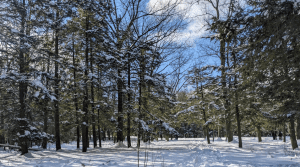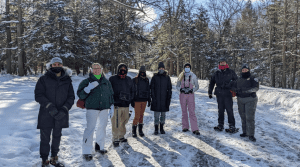
Eastern Hemlock stand at Chestnut Ridge Park.
The Eastern Hemlock (Tsuga canadensis) is a hugely important tree species upon which entire ecosystems depend. This species provides stream habitat for trout species, creates habitat for countless native plant and animal species, and enhances any outdoor recreation experience. Unfortunately, these majestic trees are under attack from the Hemlock Woolly Adelgid (HWA), an invasive, aphid-like insect.
Slowing the spread of HWA is the most important way we can help preserve our hemlock forests. The early detection of emerging infestations is a great way to do this, but we need volunteers like you to help!

- Check out our HWA Virtual Survey Training to learn how to identify hemlock and HWA; download iMapInvasives app to your phone and make an account; and winter hiking safety.
- Head out to one of our regions HWA Data Gap Parks. Survey while you hike! Make reports using the iMapInvasives app.
- Email our Education and Outreach Program Manager, Cecilia Pershyn, at pershycm@buffalostate.edu to be added to our HWA Community Scientist Bulletin. You’ll receive email updates on HWA survey, photos, events, and more!
PLUS – Meet us out in the field!
Join us at College Lodge Forest on March 12, 2022 at 10:00 AM or at Rattlesnake Hill WMA on April 9, 2022 at 11 AM for a HWA Walk and Talk.
While we hike, we will discuss the ecological importance of hemlock trees and the threat by hemlock woolly adelgid. We will demonstrate how to identify hemlocks, look for HWA infestations, and make reports to iMap. To make the most out of the experience, attendees are encouraged to download iMapInvasives app to their phone and make an account prior to the Walk and Talk. Hope to see you there!

A group of community scientists surveying for HWA in Chestnut Ridge Park.


